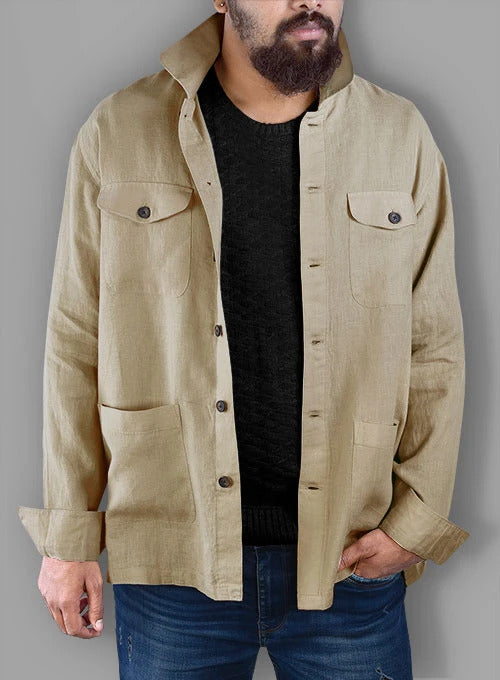Shirts are available in many different styles. While you might be familiar with some of them, you probably don't know all of them. There are overshirts, for instance, that are designed specifically to be worn in conjunction with another shirt. You can wear overshirts year-round while embracing this alternative shirt style in your outfits. Before doing so, however, you should learn the basics of overshirts.
What Is an Overshirt?
An overshirt is a type of loose-fitted shirt that's designed to be worn over another shirt. It's part of a layered outfit. Layered outfits are characterized by the use of multiple layers of garments. To create a layered outfit, you'll have to wear at least one garment over another garment.
You can create a layered outfit by wearing an overshirt. Overshirts are designed to be worn over another shirt. Maybe you want to wear a t-shirt, or perhaps you want to wear a button-up shirt. After putting on a "base" layer such as this, you can put on the overshirt. The overshirt will sit on top of the t-shirt or button-up shirt, thereby creating a layered outfit.
Overshirts vs Regular Shirts
They may look the same, but overshirts are different from regular shirts. They are both upper-body garments, and they are both available in many of the same materials and colors. Only overshirts, though, are designed to be worn over another shirt.
Regular shirts are not necessarily designed to be worn over another shirt. They typically fit tighter than overshirts. Many regular shirts contour to the shape of your body when worn. And with little or no extra space, you may struggle to wear them over another shirt.
Overshirts offer a solution. While regular shirts are typically tight-fitted, overshirts are loose-fitted. Since they are designed to be worn over another shirt, overshirts fit more loosely than regular shirts.
Advantages of Wearing an Overshirt
Why should you wear an overshirt exactly? For starters, they are a breeze to take on and off. Most overshirts feature a button-up front. You don't have to worry about pulling them over your head. With the buttons unfastened, you can pull your arms through the sleeves, at which point you'll be good to go.
Overshirts are also comfortable. As previously mentioned, they feature a loose-fitted construction. Some shirts have a tight-fitted construction that will constrict your body when worn. This isn't an issue with overshirts. There are many different types of overshirts, but they all have a loose-fitted construction. You can comfortably wear an overshirt all day long without it constricting your body or otherwise causing discomfort.
Another advantage of wearing an overshirt is warmth. While you can wear them year-round, overshirts are particularly beneficial during the fall and winter months. An overshirt will create another barrier of thermal protection. Each shirt that you wear will trap some of your body heat. By wearing an overshirt, you'll have multiple layers of thermal protection -- and each of these layers will trap some of your body heat.

What to Look for in an Overshirt
When shopping for an overshirt, make sure the color matches the garments that you intend to wear with it. Overshirts are available in dozens of colors. Since you'll be wearing the overshirt with another shirt, you'll need to choose an appropriate color.
Beige is a popular color in which overshirts are made. As a universal color, beige matches most other colors. It's a soft earth tone that's easy to incorporate into your outfits. Nonetheless, overshirts are available in many other colors. Whether you prefer beige, olive, white or any other color, you should make sure it matches your other garments.
You should also consider the material when choosing an overshirt. Some overshirts are made of cotton. Cotton is an all-around great choice of material for overshirts. It's soft, lightweight and easy to clean. Other overshirts are made of linen. Linen overshirts are arguably better than their cotton counterparts. Linen is thinner and lighter than cotton, so linen overshirts are easy to wear over other shirts.
Not all overshirts have the same pocket style. You may discover that most overshirts have pockets on the front. But the number of pockets, as well as the location of their pockets, may vary. Some overshirts have a single pocket on the front, whereas others have two or three pockets on the front. If you're going to buy an overshirt, you should consider the pocket style.
You may want to choose a custom-sized overshirt. Overshirts are available in fixed sizes and custom sizes. Fixed sizes consist of generic sizes, which may or may not fit your body. Custom sizes, conversely, are those that match your body's own measurements.
With a custom-sized overshirt, you can rest assured knowing that it will fit. Custom-sized overshirts are made using your measurements. You can specify your measurements when ordering a custom-sized overshirt. As long you enter the correct measurements, you'll receive an overshirt that fits your body perfectly. There's no substitution for a custom-sized overshirt.
Tips on Wearing an Overshirt
There's really no wrong way to wear an overshirt. You can wear an overshirt over just about any shirt. If you're only wearing an overshirt for warmth, you may want to button up the front so that it traps more of your body heat. If you're wearing it for aesthetics, on the other hand, you may want to leave the buttons unfastened.
With the buttons unfastened, your undershirt will be visible. You'll be able to see both your overshirt and your undershirt. Assuming you choose an overshirt in the right color, the two garments should complement each other.
You may want to press your overshirt with an iron before wearing it. Most overshirts are made of an organic material like cotton and linen. While organic materials such as these are soft, they are also susceptible to wrinkles. Pressing your overshirt with an iron will eliminate any stubborn wrinkles so that your overshirt has a smooth and clean texture.


